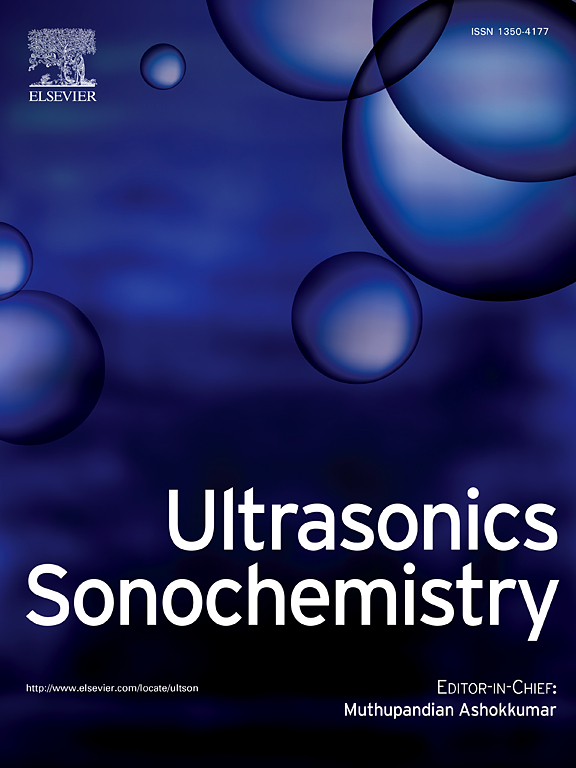Ultrasonication-assisted lipase-catalyzed esterification of chlorogenic acid: A comparative study using fatty alcohol and acids in solvent and solvent-free conditions
IF 8.7
1区 化学
Q1 ACOUSTICS
引用次数: 0
Abstract
Chlorogenic acid, a well-known antioxidant, has potential applications in health care, food, and cosmetic sectors. However, its low solubility hinders its application at the industrial scale. The primary goal of the present study was to increase the lipophilic property of chlorogenic acid through esterification using an ultrasonication approach and Novozym® 435 as the catalyst. The esterification was executed in two ways. In the first method, chlorogenic acid was converted to chlorogenic acid ester using octanol in a solvent-free reaction. Catalytic factors such as reaction time (12 h ∼ 36 h), enzyme dosage (10 ∼ 50 mg), and ultrasonication power (90 ∼ 150 W) were optimized using Box-Behnken design (BBD) while temperature (60 ℃) and molar ration (chlorogenic acid/octanol, 1:500) were kept constant. A maximum conversion rate of 95.3 % was achieved when the esterification was performed for 12 h at 120 W ultrasonication power and 50 mg enzyme dosage. Contrary to the first method, when esterification was done using caprylic acid in the presence of 2-methyl-2-butanol as a solvent, the conversion rate was relatively low. Despite optimization of factors including molar ratio, enzyme dosage, and reaction time, the highest conversion rate achieved was of only 36.8 %. Moreover, molecular docking results revealed that the lowest binding energy was between lipase and octanol. The finding of the study clearly stated that the esterification of chlorogenic acid was more effective in a solvent-free condition as compared to in the presence of solvent.
超声辅助脂肪酶催化绿原酸酯化:脂肪醇和酸在溶剂和无溶剂条件下的比较研究
绿原酸是一种众所周知的抗氧化剂,在保健、食品和化妆品领域具有潜在的应用前景。然而,其溶解度低,阻碍了其在工业规模上的应用。本研究的主要目的是通过超声法和Novozym®435催化剂酯化绿原酸来提高其亲脂性。酯化反应以两种方式进行。第一种方法是在无溶剂反应中用辛醇将绿原酸转化为绿原酸酯。采用Box-Behnken设计(BBD)对反应时间(12 h ~ 36 h)、酶投加量(10 ~ 50 mg)、超声功率(90 ~ 150 W)等催化因素进行优化,同时保持温度(60℃)和摩尔比(绿原酸/辛醇,1:500)不变。超声功率为120 W,酶投加量为50 mg,反应时间为12 h,酯化率最高可达95.3%。与第一种方法相反,当使用辛酸在2-甲基-2-丁醇作为溶剂下进行酯化时,转化率相对较低。尽管对摩尔比、加酶量、反应时间等因素进行了优化,但最高转化率仅为36.8%。此外,分子对接结果显示,脂肪酶与辛醇之间的结合能最低。研究结果清楚地表明,绿原酸在无溶剂条件下的酯化反应比有溶剂条件下的酯化反应更有效。
本文章由计算机程序翻译,如有差异,请以英文原文为准。
求助全文
约1分钟内获得全文
求助全文
来源期刊

Ultrasonics Sonochemistry
化学-化学综合
CiteScore
15.80
自引率
11.90%
发文量
361
审稿时长
59 days
期刊介绍:
Ultrasonics Sonochemistry stands as a premier international journal dedicated to the publication of high-quality research articles primarily focusing on chemical reactions and reactors induced by ultrasonic waves, known as sonochemistry. Beyond chemical reactions, the journal also welcomes contributions related to cavitation-induced events and processing, including sonoluminescence, and the transformation of materials on chemical, physical, and biological levels.
Since its inception in 1994, Ultrasonics Sonochemistry has consistently maintained a top ranking in the "Acoustics" category, reflecting its esteemed reputation in the field. The journal publishes exceptional papers covering various areas of ultrasonics and sonochemistry. Its contributions are highly regarded by both academia and industry stakeholders, demonstrating its relevance and impact in advancing research and innovation.
 求助内容:
求助内容: 应助结果提醒方式:
应助结果提醒方式:


